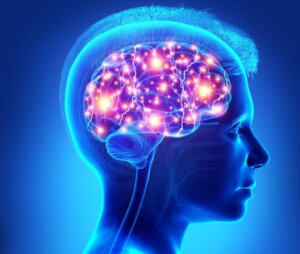The Role of the Prefrontal Cortex in Teens

With adolescence, come distinctive and profound changes at all levels. One such change is the mental one. The psychologist, Stanley Hall, defined it as “a time of storm and stress”. It’s certainly a period that’s characterized by emotional intensity, derived from deep hopes and fears. Indeed, without a doubt, it’s seen as a rather awkward phase. However, there’s a reason for this. It’s the fact that the prefrontal cortex doesn’t usually fully mature until the age of 24.
From the biological level, adolescence occurs in the second decade of life between ten and 13 years of age (coinciding with puberty) and up to 18-25 years. This depends on cultural diversity.
“Although many boys and girls go through adolescence without experiencing particular difficulties, it can be affirmed that during these years, problems increase in three areas: conflicts with parents, emotional instability and, above all, risk behaviors”.
-Olive Delgado-

Executive functions
Executive functions are the set of mental processes that allow us to consciously control different processes such as our thoughts, behaviors, and emotionality. They’re as follows:
- Working memory.
- Attentional control.
- Decision making.
- Planning.
- Organization of time.
- Anticipation of consequences.
- Goal setting.
- The ability to accept our own and others’ points of view.
It’s the ups and downs in these executive functions that make teens behave in their characteristic way. As a rule, they’re not too good at organizing themselves, setting meaningful and realistic goals, and anticipating the consequences of their actions. Moreover, they’re often impulsive in making decisions. It’s mainly because, having recently emerged from childhood when they were often sheltered, they underestimate the dangers of the real world.
Teens seek to experiment in a world where they’ll have to find their place. However, this is a difficult mission. In fact, it’s one in which they’ll often have to face and accept certain contradictions.
“An immature brain is a vulnerable brain, and therefore risk behaviors can compromise its development.”
-Crews-
The prefrontal cortex
The idea that the brain continues to form and develop after childhood is relatively new. The areas of the brain that support basic functions, such as those that control movement or sensory systems (touch, sight, smell, and taste), are the first to mature.
The brain regions that appeared later in our evolution and that significantly differentiate us from other species are also the ones that take the longest to mature. One of them is the region of the brain responsible for controlling and regulating executive functions. It consists of the prefrontal cortex (PFC) and the anterior cingulate cortex (ACC).
“Among the mental faculties that depend on the frontal lobe are the ability to control instinctive impulses, decision making, planning and anticipating the future, attentional control, the ability to perform several tasks at the same time, the temporal organization of behavior, the sense of responsibility towards oneself and others, and the empathetic capacity”.
-Antonio Damasio-

Working memory
Working memory reaches an adult’s level of functioning during the course of adolescence. The brain regions responsible for controlling this cognitive function are the dorsolateral prefrontal cortex (dlPFC) and the ventrolateral prefrontal cortex (vlPFC).
A 2006 study compared the working memory performance of individuals in late and early adolescence. It concluded that the performance in the group of children was lower. This is due, among other factors, to the fact that the PFC of people in the early stages of adolescence is far from fully developed.
“It is brain maturation that will allow the adolescent to adapt to the environment, for example, through structural and functional brain remodeling in frontal and corticolimbic regions, and the special plasticity of the brain at that time of life “.
-Crews-
Improved connections
It should be noted that these changes in (among other regions) the prefrontal cortex and the cingulate cortex, don’t just happen. They also improve connections in the brain. In fact, improved electrical connections are established between different regions. Furthermore, they improve connections with structures such as the amygdala (the center that regulates emotions), the hippocampus (an important region for memory), and the caudate nucleus (extremely important for motivation).
Children are usually really curious about the rules that govern the physical world, such as gravity. On the other hand, teens are extremely interested in the rules that govern the social world in which they’ll have to define their identity. This is an area where impulsiveness is usually highly penalized. However, as they gain experience, their prefrontal cortex will mature and connections between various key centers in their brains improve. Consequently, they become better able to regulate their behavior.
With adolescence, come distinctive and profound changes at all levels. One such change is the mental one. The psychologist, Stanley Hall, defined it as “a time of storm and stress”. It’s certainly a period that’s characterized by emotional intensity, derived from deep hopes and fears. Indeed, without a doubt, it’s seen as a rather awkward phase. However, there’s a reason for this. It’s the fact that the prefrontal cortex doesn’t usually fully mature until the age of 24.
From the biological level, adolescence occurs in the second decade of life between ten and 13 years of age (coinciding with puberty) and up to 18-25 years. This depends on cultural diversity.
“Although many boys and girls go through adolescence without experiencing particular difficulties, it can be affirmed that during these years, problems increase in three areas: conflicts with parents, emotional instability and, above all, risk behaviors”.
-Olive Delgado-

Executive functions
Executive functions are the set of mental processes that allow us to consciously control different processes such as our thoughts, behaviors, and emotionality. They’re as follows:
- Working memory.
- Attentional control.
- Decision making.
- Planning.
- Organization of time.
- Anticipation of consequences.
- Goal setting.
- The ability to accept our own and others’ points of view.
It’s the ups and downs in these executive functions that make teens behave in their characteristic way. As a rule, they’re not too good at organizing themselves, setting meaningful and realistic goals, and anticipating the consequences of their actions. Moreover, they’re often impulsive in making decisions. It’s mainly because, having recently emerged from childhood when they were often sheltered, they underestimate the dangers of the real world.
Teens seek to experiment in a world where they’ll have to find their place. However, this is a difficult mission. In fact, it’s one in which they’ll often have to face and accept certain contradictions.
“An immature brain is a vulnerable brain, and therefore risk behaviors can compromise its development.”
-Crews-
The prefrontal cortex
The idea that the brain continues to form and develop after childhood is relatively new. The areas of the brain that support basic functions, such as those that control movement or sensory systems (touch, sight, smell, and taste), are the first to mature.
The brain regions that appeared later in our evolution and that significantly differentiate us from other species are also the ones that take the longest to mature. One of them is the region of the brain responsible for controlling and regulating executive functions. It consists of the prefrontal cortex (PFC) and the anterior cingulate cortex (ACC).
“Among the mental faculties that depend on the frontal lobe are the ability to control instinctive impulses, decision making, planning and anticipating the future, attentional control, the ability to perform several tasks at the same time, the temporal organization of behavior, the sense of responsibility towards oneself and others, and the empathetic capacity”.
-Antonio Damasio-

Working memory
Working memory reaches an adult’s level of functioning during the course of adolescence. The brain regions responsible for controlling this cognitive function are the dorsolateral prefrontal cortex (dlPFC) and the ventrolateral prefrontal cortex (vlPFC).
A 2006 study compared the working memory performance of individuals in late and early adolescence. It concluded that the performance in the group of children was lower. This is due, among other factors, to the fact that the PFC of people in the early stages of adolescence is far from fully developed.
“It is brain maturation that will allow the adolescent to adapt to the environment, for example, through structural and functional brain remodeling in frontal and corticolimbic regions, and the special plasticity of the brain at that time of life “.
-Crews-
Improved connections
It should be noted that these changes in (among other regions) the prefrontal cortex and the cingulate cortex, don’t just happen. They also improve connections in the brain. In fact, improved electrical connections are established between different regions. Furthermore, they improve connections with structures such as the amygdala (the center that regulates emotions), the hippocampus (an important region for memory), and the caudate nucleus (extremely important for motivation).
Children are usually really curious about the rules that govern the physical world, such as gravity. On the other hand, teens are extremely interested in the rules that govern the social world in which they’ll have to define their identity. This is an area where impulsiveness is usually highly penalized. However, as they gain experience, their prefrontal cortex will mature and connections between various key centers in their brains improve. Consequently, they become better able to regulate their behavior.
All cited sources were thoroughly reviewed by our team to ensure their quality, reliability, currency, and validity. The bibliography of this article was considered reliable and of academic or scientific accuracy.
- Delgado, A. O. (2007). Desarrollo cerebral y asunción de riesgos durante la adolescencia. Apuntes de psicología, 25(3), 239-254.
- Palacios, X. (2019). Adolescencia:¿ una etapa problemática del desarrollo humano?. Revista Ciencias de la Salud, 17(1), 5-8.
- Suarez, R. O. (2013). Impulsividad y agresividad en adolescentes. Ediciones Díaz de Santos.
- Stelzer, F., Cervigni, M. A., & Martino, P. (2010). Bases neurales del desarrollo de las funciones ejecutivas durante la infancia y adolescencia. Una revisión. Revista chilena de neuropsicología, 5(3), 176-184.
This text is provided for informational purposes only and does not replace consultation with a professional. If in doubt, consult your specialist.







